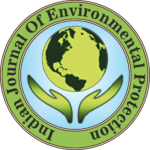IJEP 41(6): 693-697 : Vol. 41 Issue. 6 (June 2021)
R. K. Sangeetha1*, K. Arumugam1, T. Karthika1, A. T. Manikandan1 and S. Karthi2
1. Kongu Engineering College, Department of Civil Engineering, Perundurai – 638 060, Tamil Nadu, India
2. Kongu Engineering College, Department of Mechanical Engineering, Perundurai – 638 060, Tamil Nadu, India
Abstract
Understanding the water quality for drinking and agricultural uses is important. The main sources for the water contamination in the rivers are industries, agriculture and domestic sources. Most of the industries and cities are located along the river basin which is a convenient place to discharge waste materials. Chemical waste products from the industries, like paper mills, leather industries and dyeing industries sometimes accidentally discharge harmful chemicals into rivers in high concentrations that affect all living beings. In order to assess the water quality in the Cauvery river, samples were collected and analyzed for turbidity, pH, chloride, total hardness, total dissolved solids, chemical oxygen demand, dissolved oxygen, biochemical oxygen demand, etc. Qualitative ratings classified the river waterfalls into the category very poor according to the water quality index. The water quality ranges from 112.27-348.5. The overall quality of the waterfalls under the very poor category. The Cauvery river water gets polluted by the discharge of untreated wastewater from the industrial sectors.
Keywords
Cauvery river, Water quality index, Bhavani, Kokkarayanpettai
References
- Gajendran, C. and A. Jesumi. 2013. Assessment of water quality index in Cauvery river basin: A case study on Tiruchchirappalli district, Tamil Nadu, India. Universal J. Env. Res. Tech., 3(2): 137-140.
- Sebastian, J. and S. M. Yamakanamardi. 2013. Assessment of water quality index of Cauvery and Kapila rivers and at their confluence. Int. J. Lakes Rivers. 6(1): 59-67.
- Sukumaran, J. and S. M. Devarayan. 2016. Evaluation of water quality of Kaveri river in Tiruchirappalli district, Tamil Nadu by principal component analysis. Current World Env., 11(1): 89-95.
- Begum, A. and Harikrisha. 2008. Study on the quality of water in some streams of Cauvery river. J. Chem., 5(2): 377-384.
- Susheela, S., et al. 2014. Study of Cauvery river water pollution and its impact on socio-economic status around KRS dam, Karnataka, India. J. Earth Sci. Geotech. Eng., 4(2): 91-109.
- Basu, S. and K. S. Lokesh. 2012. Evaluation of Cauvery river water quality at Srirangapatna in Karnataka using principal component analysis. Int. J. Eng. Sci., 1(4): 6-12.
- Horton, R. K. 1965. An index number system for rating water quality. J. Water Poll. Cont. Fed., 37(3): 300-305.
- APHA, 1995. Standard methods for the examination of water and wastewater (7th edn). American Public Health Association, Washington DC.
- Arumugam, K., A.R. Kumar and K. Elangovan. 2014. Assessment of groundwater quality using water quality index in Avinashi-Tirupur-Palladam region, Tamil Nadu, India. Int. J. Appl. Eng. Res., 9(22): 12177-12191.
- ISI. 2012. Status of surface and groundwater resources. Indian Standards Institution, New Delhi.
- Giljanovic, N. S. 1999. Water quality evaluation by index in Dalmatia. Water Res., 33(16): 3423-3440.
- Ramakrishnaiah, C. R., C. Sadashivah and G. Ranganna. 2009. Assessment of water quality index for the groundwater in Tumkur taluk, 13. IS 10500. 1991. Indian standard drinking water specification (first revision). Bureau of Indian Standards. pp 1-8.
- Arumugam, K. and K. Elangovan. 2009. Hydro-chemical characteristics and groundwater quality assessment in Tirupur region, Coimbatore district, Tamil Nadu state, India. Env. Geol., 58(7): 1509-1520.
- Ellis, J. H. 1987. Stochastic water quality optimization using imbedded chance constraints. Water Resour. Res., 123(1): 2227-2238.
